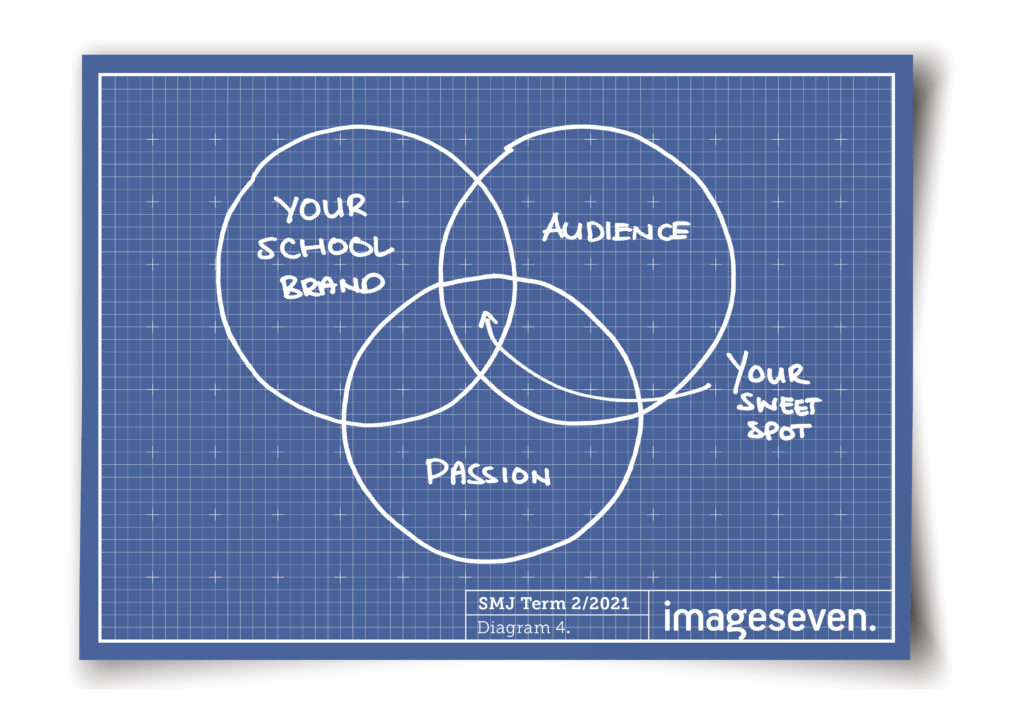When next your Board suggests you solve your school’s enrolment challenges by “just getting us out there,” you know it is not that simple. Here is why … along with a step-by-step framework for explaining it.
Your school does not want attention. Your school wants enrolments. Your school wants enrolments because enrolments mean revenue. Together, enrolments and revenue are the basic resources required to fulfil your school’s mission: students who want to learn and money to hire staff to help them learn.
To achieve student enrolments and the associated revenue, your school must sell itself as the only credible alternative for appropriate families. To do this, your school must first gain their attention. This means that every school, including yours, needs to be in the business of getting attention, whether you feel comfortable doing so or not and whether you feel like your school warrants the attention or not. In short, being a school Head means you are always in attention seeking mode.
This is where many think the “just get us out there” equation is resolved. But it is not.
The only way to get attention is to tell stories. In schools this often happens without strategy or design. Almost everything about your school, from the name and location down to how the telephone is answered, is telling a story about your school. Great school brands are very intentional about the stories they tell at every level.
There are two traditional ways to tell your stories: you can tell them yourself, or you can get others to tell it for you. Schools don’t naturally tell great brand stories. Your core business is educating students, not telling stories, so you need to find other storytellers. It is normal for an external storyteller to want to tell your story in a way that resonates with them and their audience. This is the challenge of public relations and word-of-mouth. But these external storytellers also have access to larger and often more targeted audiences than you can access, and that is the opportunity.
External storytellers reach large audiences because they have a history of telling stories their audience wants to hear. To their audience, those stories are timely, relevant or interesting and so they feel like the storyteller understands them and their needs. This means that a trust develops between storyteller and their audience which is the cornerstone of any positive relationship.
So, in short, when you get others to tell your story, you are renting the audience’s trust from the storyteller: sometimes without exchanging money and sometimes at great cost.
When your school brand assumes the position of storyteller for itself, you take control of the story and how it is told, but your audience significantly diminishes in size. You are telling a story about yourself and that is not as strong a position as when someone else is talking about you. Instead of an external storyteller speaking to an audience that they have invested in understanding, you are turning the table and asking the audience to instead understand you. There are far fewer people in your potential audience that care about understanding you than there are people who care about themselves. That’s the first challenge.
The next challenge is that school brands — notwithstanding being stories themselves — are usually quite poor at creating and telling more stories. Your school is good at educating students and helping them along their journey of formation into adulthood. Your staff don’t have their job security tied to creating and telling stories. Not even your communications and marketing team.
Still, when you tell your own story, trust is created with your audience … it’s just a smaller audience. This too is an opportunity because trust multiplied by time and consistency is the precise equation for growing an audience.
The third, but untraditional, way to tell your story is to not tell your story. The twist is that you tell your audience a story about themselves. There is a zone of mutual interest that occurs when you talk about an aspirational topic that is shared between you and your audience.
This is how most niche publications you engage with actually work. This is how Money magazine works, and how your investment property magazine works, and it is how this publication works. The editors of each of these publications are experts in personal finance, property investing and school communications and marketing, and they tell stories about personal finance, property investing and school communications and marketing to an audience who is already interested in these topics.
For the editors and publishers, the topics are an expression of their expertise. For the audience, the topics are an expression of their aspirations.
Brands that you know have been doing this for a long time. R.M. Williams is in the business of selling outback inspired clothing and OUTBACK magazine covers the bush lifestyle. Google is in the business of selling information and their Think with Google website covers consumer insights, digital marketing strategies and the future of marketing. Industrial giant GE is in the aviation, energy, healthcare sectors and more. Their GE Reports is an online service that covers their innovations in their sectors.
The editors and their audiences share a mutual interest. They have topics they care deeply about, and that they want to learn about.
By now you may have guessed this is the way that Google, Facebook, Instagram, LinkedIn and just about every social media platform you might use customises itself to your interests and to work in the same way. It’s just that they use algorithms for mass customisation to become the ‘expert’ in telling you stories you are most likely interested to hear. Netflix, YouTube and Spotify do it too.
So, this begs the question you can put to your Board. When getting your school ‘out there’, what stories should you tell, how should you be telling them and to whom?
This sweet spot framework is dependent on identifying your school’s area of expertise and what you would like to be known for. This, in turn, opens up the discussion about creating the distinction that separates you from your competition, but this should not be a deterrent to beginning your journey to ‘get out there’ with targeted efficiency. Start where you are, with what you know, use what you have and do what you can.
Now it is time to add a third dimension to our thinking. This framework begins with you identifying the intersection of your school’s deep knowledge, then looking for what your desired audience is also interested in. When you add in something that your school is passionate about, something that is core to the successful fulfilment of your mission, you will find your sweet spot much more enjoyable territory to occupy. While it is feasible to develop your sweet spot without being passionate about your content, it is usually the passion component that will carry you through the time required and with the consistency needed while you develop your audience.
For the sweet spot framework to work for your school, you should set your sights high. Aim to become indispensable to your audience. This means positioning your school as the leading informational expert in your content and geographic areas.
insight applied
- ‘Getting out there’ is not enough.
- Attention is a proxy measurement. You want enrolments.
- You still need attention. You get it by telling stories.
- Seek the sweet spot at the intersection of deep knowledge, what your audience is interested in and your area of passion.







